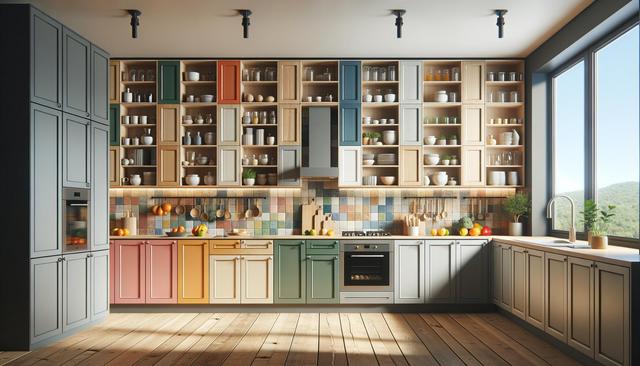Creative Kitchen Cabinet Color Ideas for Every Style
Explore creative kitchen cabinet color ideas to elevate your kitchen’s look. Whether you want to add contrast, brighten the space, or complement your existing décor, these ideas will help you choose the perfect color scheme for your kitchen.

Timeless Neutrals with a Modern Twist
Neutral colors are a reliable choice for kitchen cabinets, but modern design trends have given them a fresh appeal. Shades like soft greys, warm taupes, and off-whites offer a clean and versatile base while allowing room for accents and personalization. These colors work well in both contemporary and traditional kitchens, making them ideal for homeowners looking to blend style with longevity.
To enhance the effect of neutrals:
- Pair grey cabinets with brushed nickel hardware for a sleek finish.
- Use beige or taupe tones to warm up a minimalist kitchen layout.
- Combine cream-colored cabinets with wooden countertops for a rustic touch.
Choosing the right finish also adds character. Matte finishes provide a soft, understated look, while semi-gloss can help reflect light in smaller kitchens. These neutral tones are especially effective in open-plan layouts where they can seamlessly integrate with adjacent living areas.
Bold and Beautiful Statement Colors
For those who enjoy making a strong impression, bold cabinet colors can transform the kitchen into a focal point. Deep blues, forest greens, and even rich burgundy tones are becoming increasingly popular. These colors can add depth and sophistication to your space, especially when used on lower cabinets or kitchen islands.
Consider these combinations for visual balance:
- Pair navy blue cabinets with white marble countertops for a classic contrast.
- Use emerald green with brass fixtures to create a luxurious atmosphere.
- Try plum or wine shades on upper cabinets to create an intimate, cozy feel.
Bold colors are best used in kitchens with ample natural light or under-cabinet lighting to avoid making the space feel too enclosed. When used thoughtfully, these hues can bring personality and vibrancy to your kitchen design.
Soft Pastels for a Fresh Aesthetic
Pastel shades offer a light and airy feel, ideal for smaller kitchens or spaces that could benefit from a brightening touch. Colors like mint green, pale pink, or sky blue can bring a playful yet elegant look to your kitchen. These tones work particularly well in cottage, coastal, or vintage-inspired interiors.
Ways to incorporate pastels include:
- Mixing pastel cabinets with white tile backsplashes for a fresh, clean look.
- Combining two pastel shades, such as blush and light grey, for a subtle two-tone effect.
- Using pastel tones on upper cabinets and a neutral base for lower ones to maintain balance.
Pastels also pair nicely with natural materials like wood and stone, which can ground the softness of the colors and add texture to the overall design.
Earthy Tones for a Nature-Inspired Feel
Earth-inspired colors bring warmth and a sense of calm to kitchen spaces. Think olive green, terracotta, clay, and sandy beige—these tones connect your kitchen to the natural world and promote a relaxed atmosphere. They are particularly suitable for farmhouse, Mediterranean, or bohemian-style kitchens.
To incorporate earthy tones effectively:
- Match olive green cabinets with open wood shelving and ceramic tile flooring.
- Use terracotta accents in combination with neutral cabinetry for a pop of color.
- Choose sand-colored cabinets with black metal fixtures for a modern-rustic blend.
These colors often work well with textured materials such as reclaimed wood, rattan, or exposed brick. They create a grounded, welcoming environment that feels both timeless and on-trend.
Two-Tone and Color-Blocked Designs
Mixing two or more cabinet colors can add visual interest and help define different areas of your kitchen. Two-tone designs, where upper and lower cabinets are painted in contrasting shades, are a great way to add dimension. Similarly, color-blocked cabinetry—using bold segments of color—can create a unique aesthetic that reflects your personality.
Popular two-tone combinations include:
- White upper cabinets with navy or charcoal lower cabinets.
- Light grey paired with pastel blue for a soft yet distinctive look.
- Muted green and cream for a subtle natural palette.
Color-blocking is more adventurous and can include bold pairings like burnt orange and teal or mustard yellow and navy. This approach is ideal for contemporary and eclectic kitchens where creativity is encouraged. Just be sure to balance strong colors with neutral elements elsewhere in the room to prevent visual overload.
Conclusion: Choosing a Color That Reflects Your Style
Picking the right kitchen cabinet color is more than a design choice—it’s a reflection of your personal style and how you want your kitchen to feel. Whether you prefer the clean lines of neutrals, the drama of bold hues, or the charm of soft pastels and earthy tones, there’s a color scheme that can bring your vision to life. Consider your kitchen’s size, lighting, and existing décor when selecting your palette, and don’t be afraid to mix and match for a more customized look. With thoughtful planning, your cabinet colors can elevate your kitchen into a space that is both functional and inspiring.